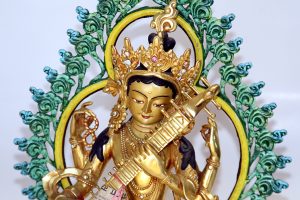Saraswati: The Goddess of Wisdom, Knowledge, and the Arts
Saraswati, the revered Hindu goddess, embodies wisdom, knowledge, and the arts. As the consort of the god Brahma, the creator of the universe, she is celebrated as the source of intellectual and creative inspiration. Saraswati’s divine presence is honored throughout India, where she is revered as the patron of learning, education, and the pursuit of knowledge.
The Origins and Mythology of Saraswati
Vedic Origins
Saraswati’s origins can be traced back to the ancient Vedas, the sacred texts of Hinduism. In the Vedas, she is depicted as a river goddess, representing the flow of knowledge and wisdom. Over time, her role evolved, and she became associated with the arts, music, and the pursuit of learning.
Stock Photos and Videos of Nepal
Shutterstock Alamy Pond5 Dreamstime 500px
Mythological Narratives
The myths and legends surrounding Saraswati are rich and diverse. She is often depicted as the consort of Brahma, the creator, and is said to have been born from his speech. Saraswati is also associated with the sacred swan, which is seen as a symbol of discernment and the ability to separate truth from falsehood.
Iconographic Symbolism
The iconography of Saraswati is steeped in symbolic meaning. She is often portrayed sitting on a lotus flower, representing purity and divine knowledge. Her four arms symbolize the four Vedas, and she holds a book, a rosary, and a musical instrument, signifying her mastery of learning, spirituality, and the arts.
 The Attributes and Iconography of Saraswati
The Attributes and Iconography of Saraswati
Symbolic Attributes
Saraswati is often depicted holding a variety of symbolic objects, each with a deeper meaning. The book she holds represents the pursuit of knowledge, the rosary signifies spirituality, and the musical instrument (usually a veena) symbolizes the arts and the power of sound.
Visual Representations
Saraswati’s iconography is characterized by her serene and graceful appearance. She is typically shown with a fair complexion, sitting on a lotus flower, and wearing a white saree. Her four arms are a distinctive feature, allowing her to hold her various symbolic attributes.
Iconographic Evolution
Over time, Saraswati’s iconography has evolved, with regional and cultural variations emerging across India. However, the core elements, such as the lotus, the swan, and the symbolic objects she holds, remain consistent in her depiction as the Goddess of Wisdom and the Arts.
 The Significance of Saraswati in Hinduism
The Significance of Saraswati in Hinduism
Patron of Knowledge and the Arts
Saraswati is revered as the deity who embodies the pursuit of knowledge, wisdom, and the creative arts. She is celebrated as the source of inspiration and the guiding force behind all intellectual and artistic endeavors.
Symbolic of Enlightenment
In Hindu philosophy, Saraswati represents the power of the intellect, the ability to discern truth from falsehood, and the attainment of enlightenment. She is seen as the embodiment of the transformative potential of education and spiritual growth.
Unifying Cultural Influence
Saraswati’s influence extends beyond the realms of religion and philosophy, as she has become a unifying cultural force in India. Her veneration is observed across diverse communities, fostering a shared appreciation for learning, the arts, and the pursuit of knowledge.
 Saraswati and the Pursuit of Learning
Saraswati and the Pursuit of Learning
Patron of Education
Saraswati is revered as the patron of education, inspiring students, scholars, and educators alike to embrace the pursuit of knowledge. She is celebrated as the embodiment of the transformative power of learning and the cultivation of wisdom.
Nurturing Creativity
In addition to her role as the Goddess of Wisdom, Saraswati is also celebrated for her influence on the creative arts. She is seen as the source of inspiration for musicians, artists, and writers, empowering them to express their talents and bring their visions to life.
Cultivating Discernment
Saraswati’s teachings emphasize the importance of discernment, the ability to distinguish truth from falsehood, and the application of knowledge for the greater good. She encourages her devotees to approach learning with a critical mindset and to use their knowledge to make a positive impact on the world.
 Celebrating Saraswati: Festivals and Rituals
Celebrating Saraswati: Festivals and Rituals
Saraswati Puja
The most prominent celebration of Saraswati is the annual Saraswati Puja, observed primarily in India and Nepal. During this festival, devotees pay homage to the Goddess of Wisdom by offering prayers, performing rituals, and seeking her blessings for academic and creative endeavors.
Vasant Panchami
Saraswati is also celebrated during the Vasant Panchami festival, which marks the arrival of spring. On this day, devotees dress in yellow, the color associated with Saraswati, and engage in cultural performances, such as music, dance, and the recitation of sacred texts.
Auspicious Rituals
Throughout the year, Saraswati is invoked during important academic events, such as the opening of schools or the commencement of new educational endeavors. These rituals, which often involve the worship of Saraswati’s image or the recitation of mantras, are believed to bring forth her blessings and ensure the success of the undertakings.
 Saraswati’s Influence on Indian Culture and Society
Saraswati’s Influence on Indian Culture and Society
Arts and Literature
Saraswati’s influence on the creative arts and literature in India is profound and enduring. She is revered as the patron of music, dance, poetry, and other artistic pursuits, inspiring generations of artists and writers to create timeless works that have shaped the cultural landscape.
Education and Learning
As the Goddess of Wisdom and Knowledge, Saraswati’s presence is deeply felt in the realm of education. She is honored in schools, colleges, and universities, her blessings sought to ensure the success and enlightenment of students and scholars.
Daily Life and Rituals
Saraswati’s influence extends beyond the realms of religion and academia, permeating into the daily lives of Hindus. Her image is often featured in homes, workplaces, and community spaces, serving as a constant reminder of the importance of learning, creativity, and the pursuit of knowledge.
 The Enduring Legacy of the Goddess of Wisdom
The Enduring Legacy of the Goddess of Wisdom
Ancient Roots
Saraswati’s origins can be traced back to the ancient Vedic texts, where she was revered as a river goddess and the embodiment of the divine feminine. Her role and significance have evolved over centuries, becoming deeply ingrained in the cultural and spiritual fabric of India.
Contemporary Relevance
Even in the modern era, Saraswati’s influence remains strong, inspiring devotees across India and around the world. She continues to be celebrated as a symbol of the transformative power of knowledge, creativity, and the pursuit of enlightenment, guiding individuals and communities in their intellectual and spiritual journeys.
Enduring Legacy
The reverence and devotion accorded to Saraswati throughout history are a testament to her enduring legacy as the Goddess of Wisdom, Knowledge, and the Arts. Her timeless teachings and the profound impact she has had on Indian culture and society continue to inspire and guide people in their personal and professional pursuits.
DISCLAIMER: This was generated with the help of AI. This technology is new and constantly improving. Please verify the accuracy before sharing.



 The Significance of Saraswati in Hinduism
The Significance of Saraswati in Hinduism Saraswati and the Pursuit of Learning
Saraswati and the Pursuit of Learning Celebrating Saraswati: Festivals and Rituals
Celebrating Saraswati: Festivals and Rituals Saraswati’s Influence on Indian Culture and Society
Saraswati’s Influence on Indian Culture and Society